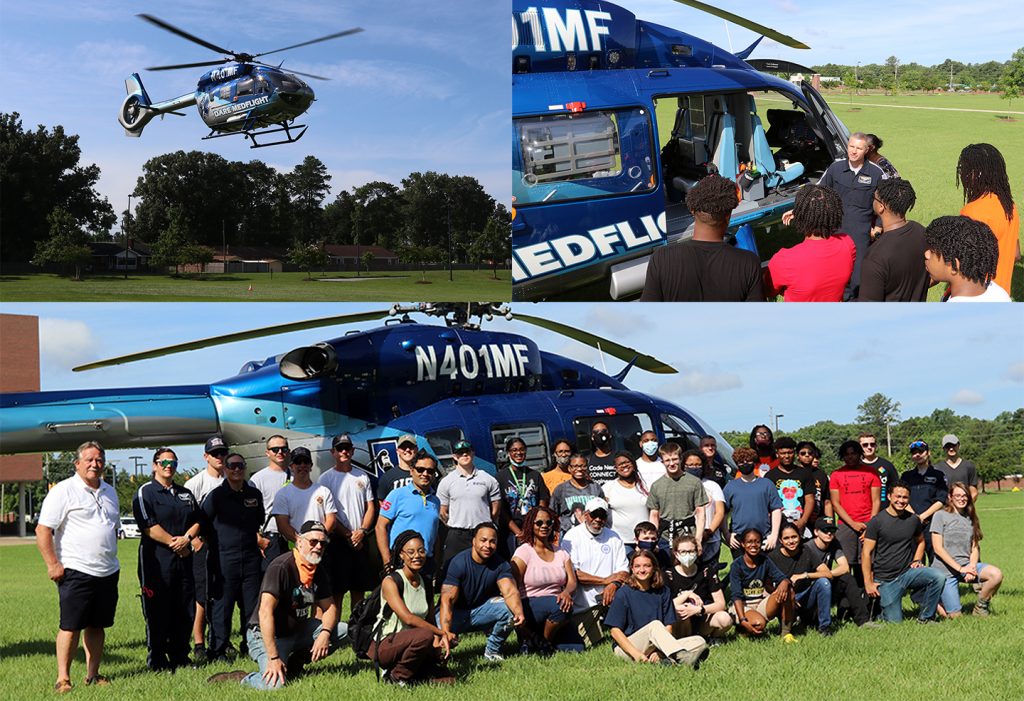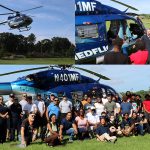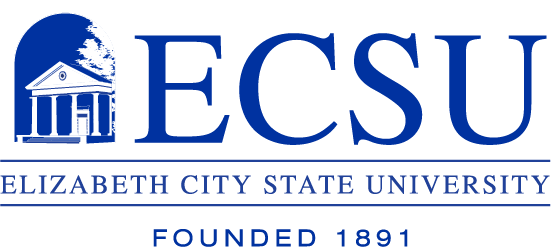NASA Summer Aerospace Academy Takes Flight on ECSU Campus

When the Dare County Medflight helicopter touched down on the lawn adjacent to Elizabeth City State University’s Fine Arts Center, pilot Andy Reed stepped out, standing at the nose of the aircraft. As the rotary blades of the helicopter slowed to a halt, about 20 high school and undergraduate mentors gathered around to listen as Reed talked about the aircraft.
Reed, a former military pilot, answered questions as the students gathered around the cockpit, peering inside. He described the engine, the fuel capacity, airspeed, and the significance of the craft in terms of aerospace technology. His talk was aimed at enlightening the participants in ECSU’s summer NASA Aerospace Academy.
Each summer two camps are held on the campus of ECSU. Dean of the School of Science, Aviation, Health, and Technology, Dr. Kuldeep Rawat, says while the NASA-sponsored aerospace academy has been taking place for a number of years, the program’s origins go back to when it was dubbed the ACE Academy – ACE stands for Aviation Career Education.
“They are learning about aerospace/aviation careers and STEM (Science Technology Engineering Math) in general,” said Dr. Rawat.
Monday, June 14, was the first day of the weeklong camp. That was the day the helicopter stopped at ECSU. The campers were able to scramble around the aircraft for photos, inspect the cockpit, and ask the crew questions.
The campers are encouraged to ask questions about aviation. They’re encouraged to deepen their understanding of STEM-related careers. That’s what the camp does; bring students who have expressed an interest in STEM careers closer to their interests.
Mr. Gooden, coordinator for the NASA aerospace academy program, says that during the weeklong session, these students will not only learn about rotary and fixed-wing aircraft, but also the growing world of drone aviation technology.
On another day the students will receive flight simulator experience. Activities also include building rockets, hot air balloons, renewable energy, field trip, and more. This summer, emergency response training component has been included to teach critical life skills. This academy will enhance their enjoyment in discovering new things, solving problems, and learning how things work.
It would seem that such an experience would cost campers and their families something, but this weeklong exploration of aerospace and aviation is free, says Gooden. Grants from NASA and Burroughs Wellcome Fund make it all possible for these future aviators and scientists.
Dr. Rawat says students simply apply and those that meet the criteria are chosen for a spot in the camp.
Although campers come from across the state, and even out of state, most of the participants come from one of the 21 Northeastern North Carolina counties served by ECSU, says Dr. Rawat. He says the program strives to balance the program between equal numbers of young men and young women. Minority students, he said, are given special emphasis as well.
“More than 70 percent are minority students, and 50 percent are females,” said Dr. Rawat, adding that 85 percent of the campers are from the 21-county region.
Since the NASA program brings in high school students, it would stand to reason that many of them may choose to enroll at ECSU later down the line. Dr. Rawat says that part of this grant is to do a follow-up on where the students go to school and what subjects they choose for majors, and he’ll know more about the results later in the year.
In the meantime, he says there are some former campers on campus as ECSU students.


